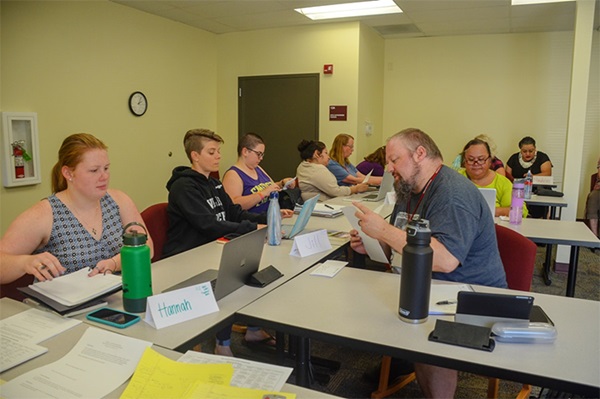Claremont School of Theology, an independent 400-student theological college in southern California, relocated to Salem over the next few years to become Willamette's third graduate school. Claremont's new Master's of Divinity students are now in Salem.
Claremont School of Theology is one of the 13 United Methodist seminaries supported by the Ministerial Education Fund apportionment of the United Methodist Church.
When Frank Rogers began teaching at the Claremont School of Theology 31 years ago, he was living and teaching in corrugated metal huts in the southern California desert.
The story has become something of a legend among the school's staff, used to illustrate Claremont's pioneering spirit and openness to doing things in new ways.
 |
| Claremont professor Frank Rogers illustrates a theological concept for seminary student Kate Kilroy during an introduction to religious education course at Willamette University on Aug. 28, 2019. (Rachel Alexander/Salem Reporter) |
Rogers is now teaching in Salem as part of an affiliation between Claremont, a stand-alone theological school founded in southern California in 1885, and Willamette University.
The two schools started exploring a merger in late 2016 and last spring agreed to move forward with a partnership that will ultimately see Claremont relocated entirely to Salem, becoming Willamette's third graduate school.
Claremont had about 430 students in master and PhD programs on its southern California campus last spring, according to Sheryl Kujawa-Holbrook, Vice President of Academic Affairs and Dean of Faculty.
Last May, both college presidents signed an affiliation agreement to begin the process of transitioning Claremont programs to the Willamette campus.
Both schools have Methodist roots, though Willamette is now a secular institution and Claremont prides itself on an interfaith focus with courses of study in Jewish history and comparative theology.
Claremont has been looking to merge with a larger institution to get the school on more stable financial footing, according to Sheryl Kujawa-Holbrook, Vice President of Academic Affairs and Dean of Faculty. That's part of a nationwide trend among stand-alone theological schools.
Claremont's student body last year ranged in age from 23 to 85, Kujawa-Holbrook said.
Claremont students may benefit from partnerships with Willamette's business school, where future pastors can learn about the basics of business or nonprofit finances, something many theology schools don't offer.
Though they're sharing some classrooms, Willamette and Claremont are still separate schools.
For now, the schools remain separate on paper. There are dozens of regulatory hurdles to clear for accreditation, student visas, financial aid and more before Claremont can become a school within Willamette.
The new Claremont arrivals had positive reviews of Salem, especially the food and natural scenery, though several students said the supply of Airbnbs and short-term rentals is lacking.
Coming from the desert of southern California, "All that water and all those trees and all those waterfalls are kind of remarkable to us," Kujawa-Holbrook said.
Kujawa-Holbrook said the school has reached out to local faith communities and hopes to engage Salem residents through lectures, community service and an annual film series the college puts on.
"We're anxious to meet local people beyond folks that are interested in a degree in religion," she said.
excerpt from a story by Rachel Alexander, Salem Reporter
One of seven apportioned giving opportunities of The United Methodist Church, the Ministerial Education Fund is at the heart of preparing people for making disciples of Jesus Christ for the transformation of the world. The 13 United Methodist seminaries help students to discover their calling through the challenging curriculum. The fund enables the church to increase financial support for recruiting and educating ordained and diaconal ministers and to equip annual conferences to meet increased demands. Please encourage your leaders and congregations to support the Ministerial Education Fund apportionment at 100 percent.





